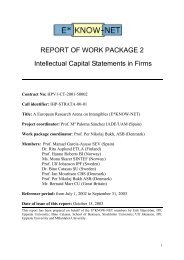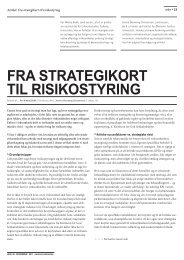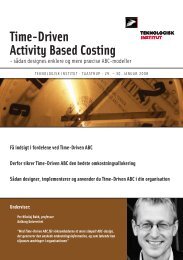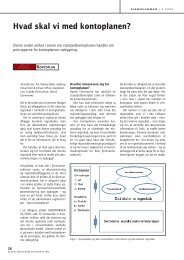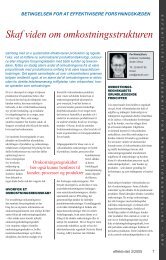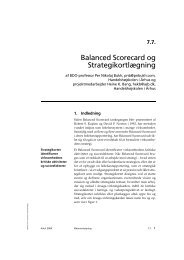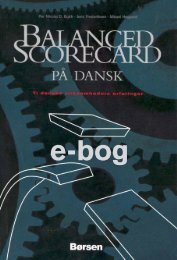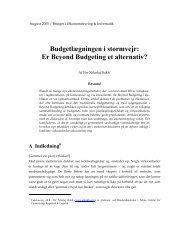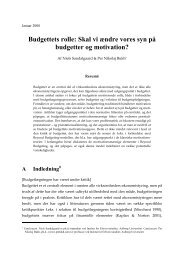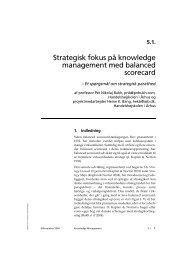guidelines for managing and reporting on intangibles (intellectual
guidelines for managing and reporting on intangibles (intellectual
guidelines for managing and reporting on intangibles (intellectual
Create successful ePaper yourself
Turn your PDF publications into a flip-book with our unique Google optimized e-Paper software.
Examples of possible indicators <str<strong>on</strong>g>for</str<strong>on</strong>g> all the <strong>intangibles</strong> menti<strong>on</strong>ed in Figures 3 <str<strong>on</strong>g>and</str<strong>on</strong>g> 4 are<br />
shown in the table below:<br />
INTANGIBLE INDICATOR Type*<br />
Highly trained staff % of employees with higher educati<strong>on</strong>, intermediate, grammar NFI<br />
school<br />
Training Activities a) Total number of training hours received by managers NFI<br />
relative to total training hours<br />
b) Total training cost per key employee<br />
FI<br />
c) Average satisfacti<strong>on</strong> of the employees with competence NFI<br />
development<br />
Employee Survey<br />
a) Average satisfacti<strong>on</strong> of the employees with training<br />
activities<br />
b) Cost of the survey<br />
c) Average satisfacti<strong>on</strong> with leadership<br />
Patents Number of patents filed over the last year NFI<br />
R&D activities R&D expenditures FI<br />
Analysis of R&D<br />
rate of return R&D as a percentage of turnover FI<br />
INTANGIBLE (C<strong>on</strong>t) INDICATOR Type*<br />
Flexibility-Structural<br />
Capital<br />
a) % of projects that are based <strong>on</strong> interdepartmental cooperati<strong>on</strong><br />
NFI<br />
b) Average employee satisfacti<strong>on</strong> with the work<br />
organizati<strong>on</strong><br />
NFI<br />
Increase codified routines % of critical processes that have a Manual NFI<br />
Use of codified routines % of critical processes that follow the Manual NFI<br />
Flexibility-Relati<strong>on</strong>al Average order resp<strong>on</strong>se time, from customer order until NFI<br />
Capital<br />
Select <str<strong>on</strong>g>and</str<strong>on</strong>g> act <strong>on</strong> key<br />
customers<br />
Loyal customers<br />
final delivery<br />
a) % of sampled customers in the customer satisfacti<strong>on</strong><br />
survey<br />
b) Average satisfacti<strong>on</strong> am<strong>on</strong>g key customers<br />
a) % of l<strong>on</strong>g-term customers (5 years or more) to total<br />
number of customers<br />
b) % of turnover related to l<strong>on</strong>g-term customers<br />
NFI<br />
FI<br />
NFI<br />
NFI<br />
NFI<br />
NFI<br />
FI<br />
Direct marketing Direct marketing expenses as a percentage of total costs FI<br />
Customer survey<br />
a) Average satisfacti<strong>on</strong> of the customers with the firm’s NFI<br />
products <str<strong>on</strong>g>and</str<strong>on</strong>g> services<br />
b) Cost of the survey<br />
FI<br />
c) Average satisfacti<strong>on</strong> with meeting firm representatives<br />
Flexibility-Human Capital a) % of work<str<strong>on</strong>g>for</str<strong>on</strong>g>ce with above-average working hours<br />
b) Cost of tele=work as a percentage of total labor costs<br />
NFI<br />
FI<br />
Job Rotati<strong>on</strong> % of work<str<strong>on</strong>g>for</str<strong>on</strong>g>ce with yearly job rotati<strong>on</strong> NFI<br />
*NFI: N<strong>on</strong>-Financial Indicator; FI: Financial Indicator<br />
Measuring accurately the cost of an intangible activity, <str<strong>on</strong>g>and</str<strong>on</strong>g> to assess its impact <strong>on</strong> the<br />
firm’s per<str<strong>on</strong>g>for</str<strong>on</strong>g>mance indicators (earnings, sales, market share, market value, etc.),<br />
appears to be a daunting task. First, because it is not always possible to identify a cost<br />
with each <str<strong>on</strong>g>and</str<strong>on</strong>g> every intangible activity. Sec<strong>on</strong>dly, because the impact of a particular<br />
intangible activity <strong>on</strong> future per<str<strong>on</strong>g>for</str<strong>on</strong>g>mance may <strong>on</strong>ly be reliably measured in very specific<br />
cases <str<strong>on</strong>g>and</str<strong>on</strong>g> is, there<str<strong>on</strong>g>for</str<strong>on</strong>g>e, more the excepti<strong>on</strong> than the rule (<str<strong>on</strong>g>for</str<strong>on</strong>g> example, the effect of R&D<br />
expenditures <strong>on</strong> patent registrati<strong>on</strong>s, are two indicators directly related).<br />
Despite these difficulties, most of the companies that disclose Intellectual Capital<br />
Reports show these two sets of indicators - indicators <strong>on</strong> <strong>intangibles</strong>, <str<strong>on</strong>g>and</str<strong>on</strong>g> per<str<strong>on</strong>g>for</str<strong>on</strong>g>mance<br />
19



